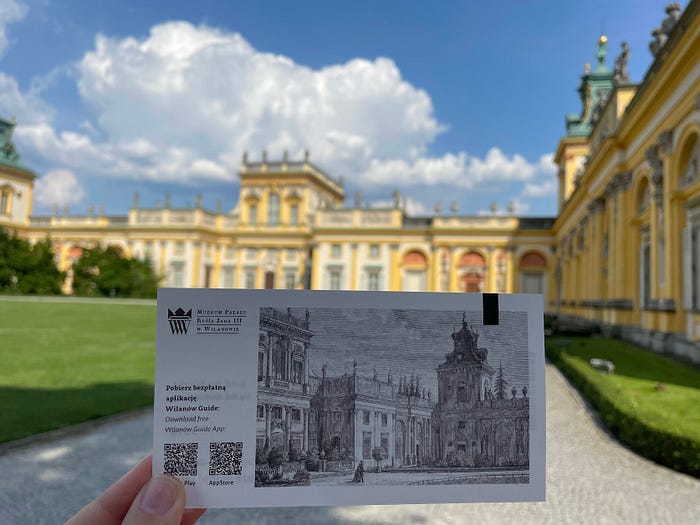On Studying Culinary History at a Baroque Palace
The Story of Compendium Ferculorum
Thank you to Chef Maciej Nowicki for sharing his expertise with me. If anyone has any corrections to my findings or anecdotes, I would be more than happy to hear them!

The age old adage claims that “the way to the heart is through the stomach.”
I couldn’t agree more — sharing a meal, and more importantly, making it from scratch, connects us like nothing else. To that end, one of my biggest dreams has always been to become a better cook. I know this comes through lifelong learning, but when the opportunity came to learn from royal chefs from a palace in a land far, far away, you betcha I took it.
The art of cooking is unusually versatile in the temporal dimension that it can be experienced in. Equal pleasure can be derived from reminiscing over childhood tastes from the past, as well as planning where to savor future courses. After all, it is saliva that is the very best sauce. When we remember or wait for a dish, we build up an appetite in anticipation, making the dish all the tastier when it arrives. Therefore, a good cook knows how to prepare his audience to engage in a mouthwatering experience, not just quickly devour a meal.
Notedly, the most misunderstood culinary dimension is the distant past. It may seem that “Hey, it’s food! It can’t possibly change much.” But, as it turns out, anthropology, archeology, economics, historiography, and ecology all converge in affecting the changing nature of global and regional gastronomy.
In fact, there is a whole research field dedicated to tracking this. I’ve been drawn to one of Poland’s gems, the 17th century Wilanów Palace before, but it is only this year that I discovered it is host to a historic culinary research centre. There lay initiatives promoting literary scholarship using sources from across Europe, as well as “progressive re-enactment,” that is, re-enactment accounting for a modern-day lack of certain historic kitchen tools and ingredients.
Wilanów’s scholars have uncovered that the earliest and best look into Poland’s culinary past can be found in Stanisław Czerniecki’s 1682 cookbook, Compendium Ferculorum. Notedly, Czerniecki wasn’t a chef, but at times a courier, a soldier, and a princeps coquorum responsible for kitchen logistics, rather than the cooking itself. He frequented the tables of aristocratic families in the King’s court, like the Lubomirski’s; one could say he had very good taste. Czerniecki observed how this ruling class satiated their hunger and collected his findings into a book of recipes, many of which would surprisingly sound foreign to the average Pole today.

As I studied from a chef at Wilanów, I learned that traditional Polish cuisine was incredibly well known because of its distinctness from others in Europe. I was expecting the historic flavours to resemble modern ones in their herby, laden with forest treasures like mushrooms and berries, nature. I was shocked to learn of the complete opposite — it was sweet and sour, closer to Asian delicacies than most European dishes! Take, for instance, chicken soup with lime which resembles pho. Another recipe in the book calls for black pudding or a type of pork sausage which scientists in Busan have linked to similar jeju dishes in older Korean culture. Therefore, Polish cuisine, even if originally not as connected to a lineage of ancient imperial resources as Western and Mediterranean Europe, experienced more global influence than other Slavic countries with whom we share more contemporary dishes.
Nota Bene: The below map showing unified Slavic territories is not intended to boast of Poland’s former might, but express the sheer variety of peoples and ecologies our territories encompassed at the height of our Golden Age.

In fact, throughout history, there have been noticeable variations between Slavic cultures and cuisines. It is a late 20th and 21st century tendency to clump Baltic, Central, and Eastern European countries together, when historically they have been different from each other. For instance, a common mistake is for tourists to visit Lithuania, Latvia, and Estonia together, when a more apt storyline emerges through a visit to Poland and Lithuania, and another to Latvia, Estonia, and Finland, and yet another to eastern Belarus and Ukraine. Another interesting discussion could examine Slavic migration patterns, genetics, and linguistics.
So why the misconceptions about traditional Polish cuisine? When did the dramatic changes leading to our current menu occur?

Unlike say Italian or French cuisine which has largely remained the same over the past few centuries, Polish fare faced 200 years of disruption. This was due to the three territorial partitions by Germanic, Russian, and Austrian invaders, followed by a tumultuous 20th century of two world wars and a forcibly imposed Communist Era. During these times, recipes were lost, destroyed, or distorted through semantics, proverbs, and propaganda. In fact, as one Wilanów chef recounts, when he was teaching at Château de Versailles, his French students were more familiar with truly traditional Polish meals than his Polish students, due to the à la polonaise method persisting in their culture, even when it lapsed from our’s.


Further clarifications about historic meals and customs can be gleaned from records like those of French courier Jean Le Laboureur. His travel journey from the 1640s recounts interactions between the powerful Gonzaga family, as well as the Wasa and Hapsburg dynasties.
Similarly, diary entries accompanying paintings like those by Rembrandt reveal information about Polish merchants and diplomats.


While the thoughtful visage of A Polish Nobleman could be Rembrandt’s attempt to illustrate a generic exotic figure, Simon Schama’s biography hints at a deeper story of the travellers the painter could have encountered as they sought out specific goods in Western Europe. Bacciarelli just as masterfully captures King Wasa later in the 18th century.
We learn that the Polish baroque flavour offered many surprises and contrasts. Plates were often full of illusions, such as czernina or blood soup (more cultures have a version of this soup than you think!) made sometimes with meat and sometimes with red berries. A common thread between dishes was that they were always well seasoned with hot spices that came to Poland through clashes with the Ottoman Empire and loops of the Silk Road. Vinegar, too, was used liberally, as was saffron, cinnamon, nutmeg, and basil, with the King’s meat often topped with . . . sugar! Olives were also widely accessible due to the far reaching corners of the Polish-Lithuanian Empire. Other unique flavours arrived in Poland via the Columbian Exchange, Swedish Deluge, and French Revolution.
It is important to note that unlike viral TikTok recipes and delivery service specials which instantaneously encompass kitchens, it took decades and decades for the effects of the Columbian Exchange to be felt, from the trade of certain goods, to their utilization and eventual incorporation into culinary practices. The story of corn is particularly interesting — for a long time, Europeans knew it as “Turkish grain,” being that it entered the continent from the East, rather than through Seville, as did so many other crops.
Nowadays, “authentic” Polish food in a bar mleczny or cafeteria with home cooked meals offers a multitude of hearty meat dishes, such as schabowy or kiełbasa, yet it turns out that poultry, not pork, was more prevalent in the past. Partridges and geese were considered cleaner meat, with sweet water fish and crawfish making some of the most common appearances on the court’s dinner plates. On the other hand, average people ate a largely vegetarian diet, oftentimes up to 200 days out of the year. Meat was expensive and required time-intensive preparation, not to mention the era’s frequent religious occurrences, including a longer and stricter Lenten season. When they did eat meat, people engaged in nose-to-tail cooking. Now with our changing preferences, both recipes and preservation methods disappear, leading to more food waste than ever before.
It is not only habits that change, but environments too. In the past, the Polish landscape contained dense, lush forests, where now we see vast plains and fields. The Vistula used to be ripe with fish weighing up to 150 kg. People farmed for self-sufficiency, not on an en masse scale. The Little Ice Age that swept the world from the 14th to 17th century also affected harvests. Since then, 75% of Polish biodiversity, and with it the splendor of many a recipe, disappeared.
Discussing the history of Polish gastronomy undoubtedly invites commentary on its future, as well. Some trends regard potato consumption steadily going down and apple tree species (fun fact — apples originated in Asia) disappearing from nearly 200 easily identifiable species to just under 30. Quality is degraded by pesticides covering everything, inside and out, in large scale farming.
Thus, looking forward, I am inclined to think that most people will again be vegetarians by 2030. Warsaw is already known as the vegan capital of Europe, and the quite worrying scarcity and decline in quality of meat may bring around a return to our roots (pun absolutely intended) sooner than we think. Looking back, when I cooked in Germanic regions earlier this summer, I also noticed people using water rather than broth as a base for soups.
Having developed a deeper appreciation for all things food and history, I encourage everyone to take a look inside their familial cookbooks, talk with older relatives, and try their hand at making some special dishes. We cannot become a “two finger generation,” knowing only how to use our thumbs to type, rather than actually craft something by hand.
I’m pleased that research will continue in Wilanów, as well as the Centre for Culinary Heritage at Nicolaus Copernicus University in Toruń, another important foodie destination for all things pierniki (gingerbread)! Continued international cooperation and sharing of archives will be critical.
I sincerely look forward to inviting the Wilanów chefs to NYC to cook a meal together. While I won’t be at a palace anytime soon, thanks to my copy of Compendium Ferculorum, I know I can still be a “baroque” college student and enjoy a meal fit for a King! What a pity that he didn’t have a chance to try some of my grandma’s bigos, though he probably wouldn’t have known what it was!




